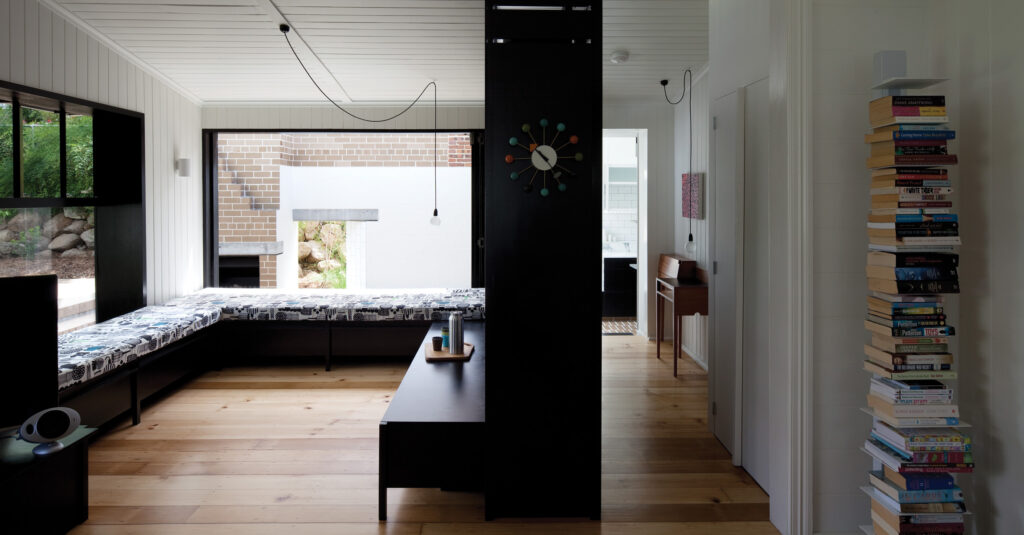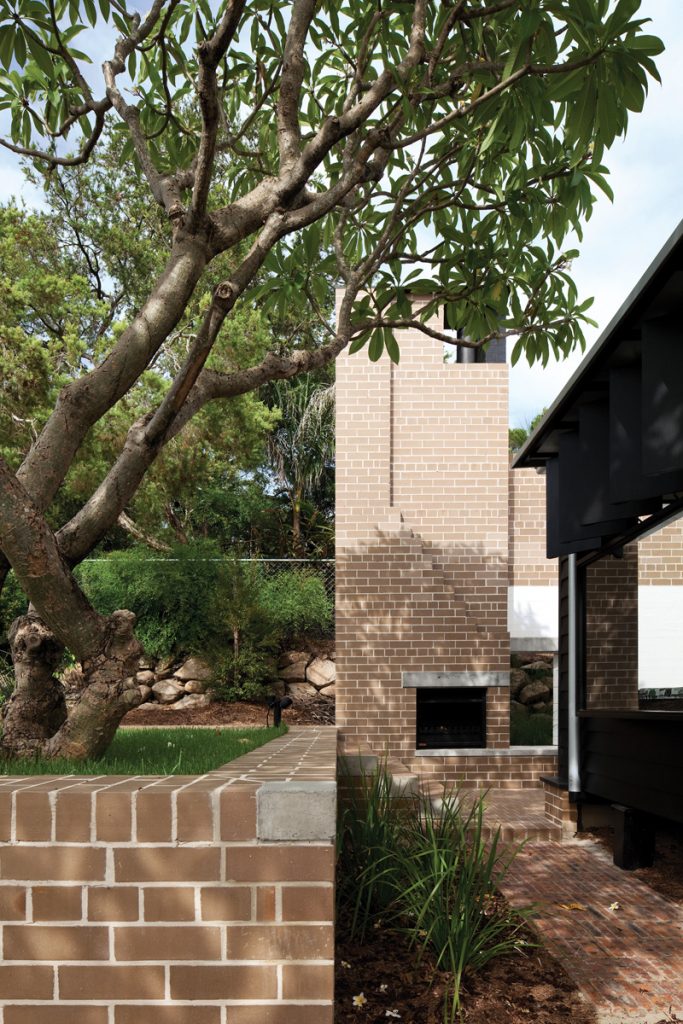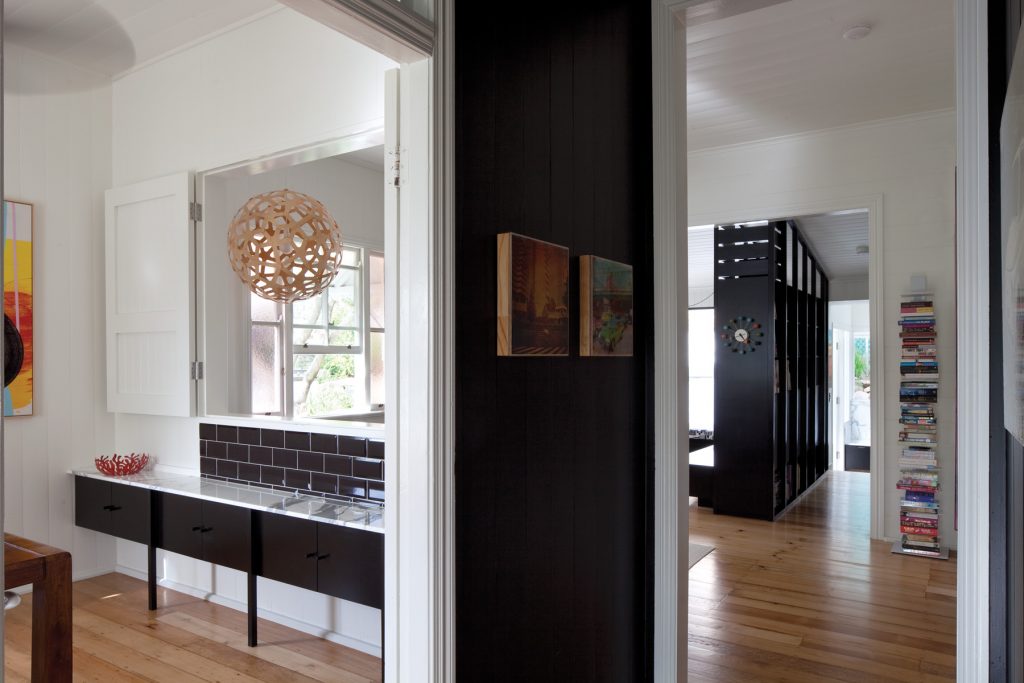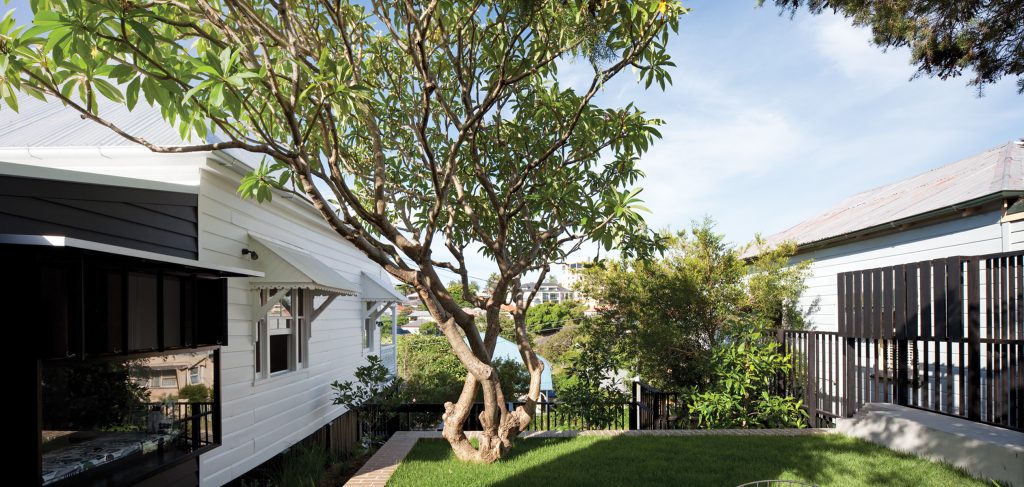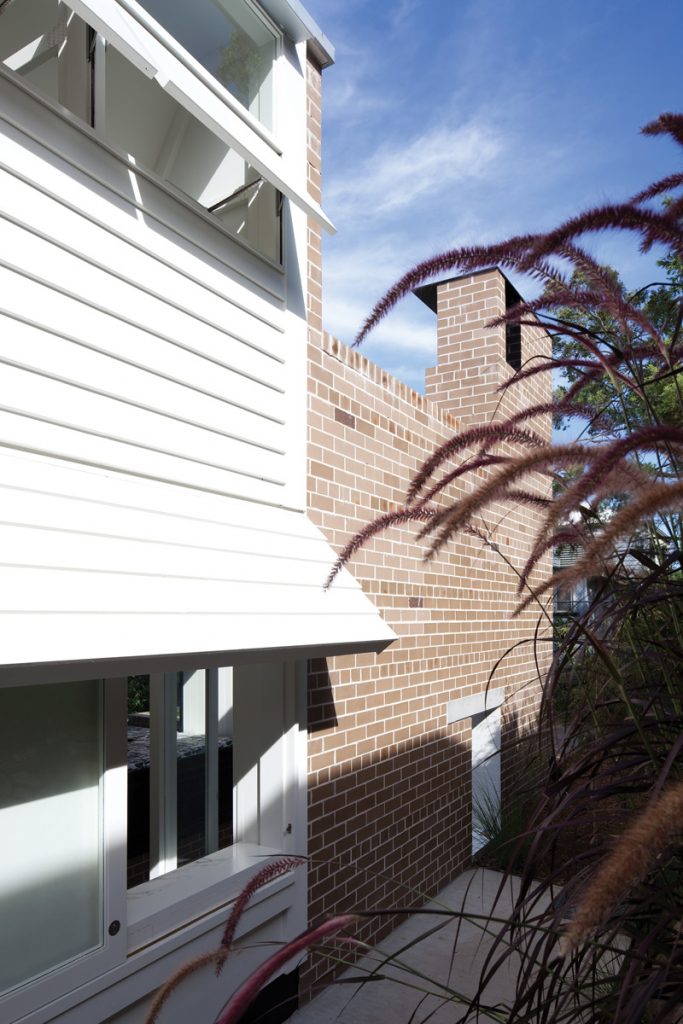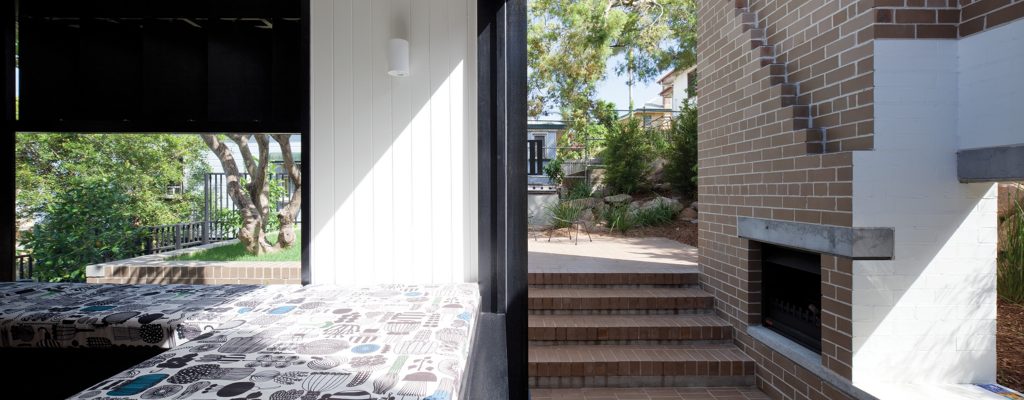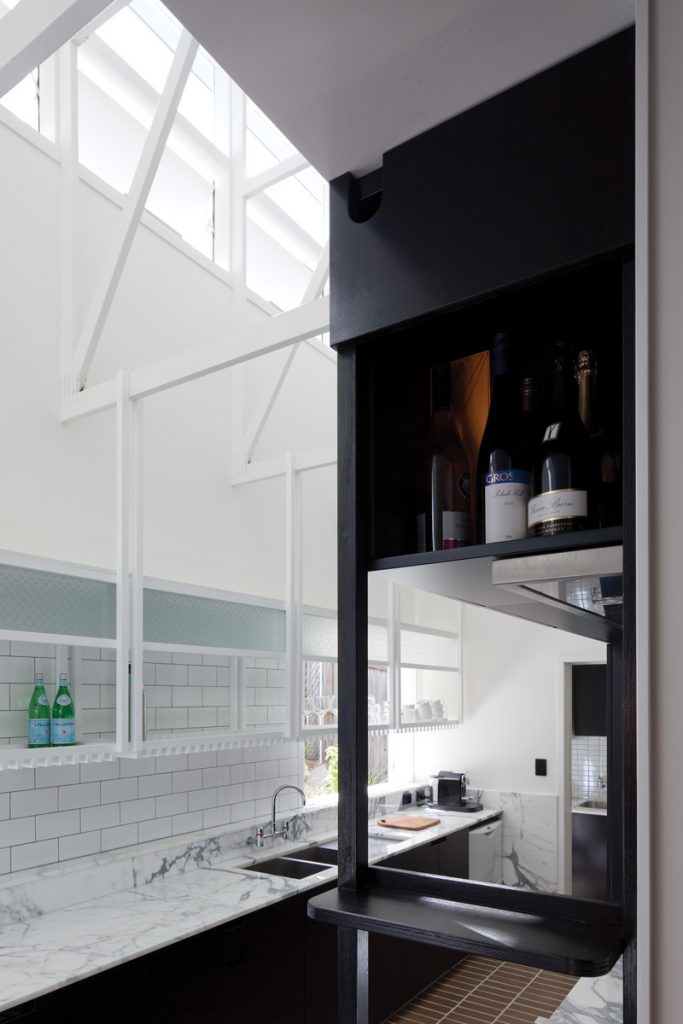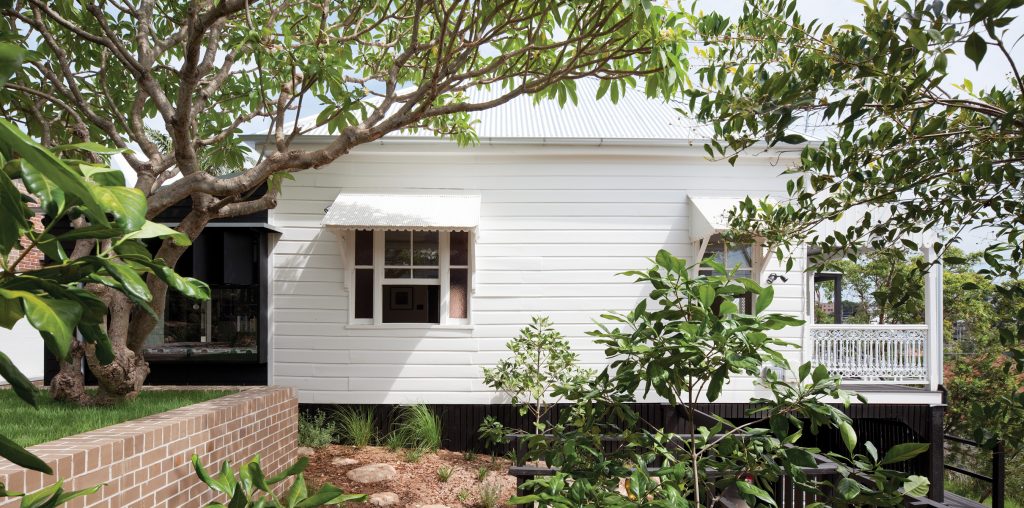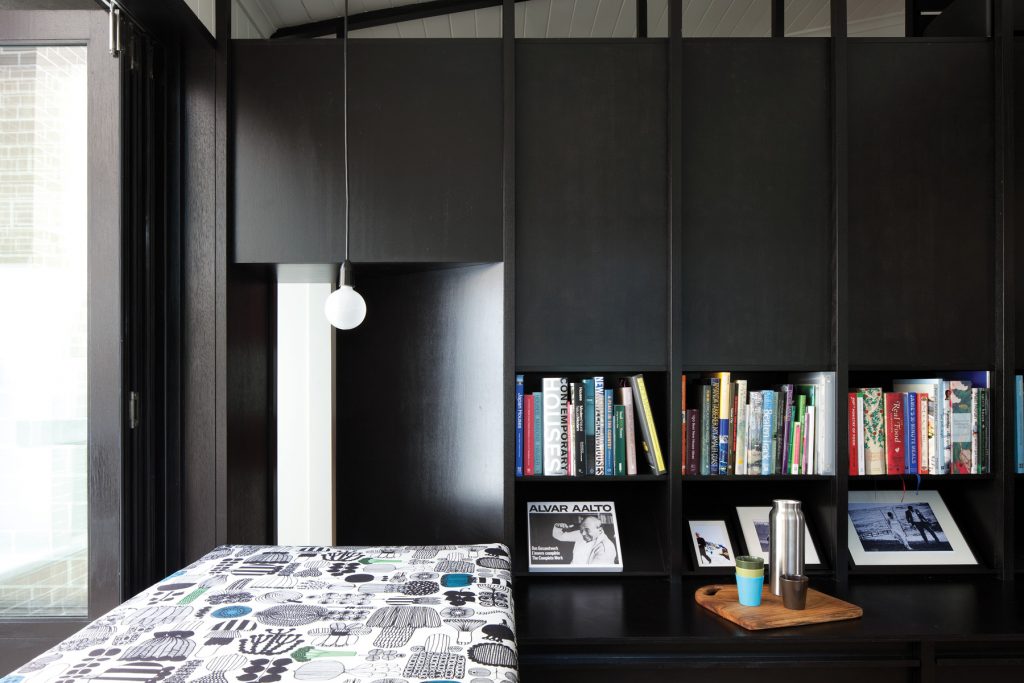Sideways—Brisbane Timber Cottage Renovation
This renovation of a classic Brisbane timber cottage was all about maximising, not necessarily increasing, space – and taking advantage of a precious side block.
Standing under a frangipani in the side garden of this house, looking west across one of Brisbane’s suburban hollows to the ridge line opposite, I imagined the family who lives here might just go camping in this garden some weekend (near the open fireplace would be a good spot). They may never do so, of course; I’m daydreaming, but coming upon this wedge of open space, a small miracle of preservation in an increasingly close-packed inner suburb, occasioned this “green thought in a green shade”. Reverie is one of the many functions of gardens. The key to Owen and Vokes’ alterations and additions to the four-room cottage is the decision to retain this fortuitous open space. The site is 400 square metres and consists of two lots, each with a 10-metre frontage. The cottage sits predominantly on the southern lot, hugging the site boundary, leaving most of the northern lot as open space.
Timber and tin four-room cottages, with pyramid or short- ridged roofs, came into vogue in Queensland in the late nineteenth century, and are commonly referred to as workers’ cottages. This particular cottage has the distinction of a central hallway and a return verandah on the southern side. A lean-to at the rear added two rooms and a bathroom at the end of the side verandah. Part of the side verandah was enclosed for a second bathroom.
Owen and Vokes have retained the rectangular core of the (now six) central rooms, and demolished the bathroom and a small rear bay addition. They have added a new kitchen and laundry to the rear and reconfigured the side verandah as a novel kind of space, a “verandah bathroom”. The net result of this program of work has been an increase in the floor area of the cottage, and thus in its site cover, of only a few square metres. Based on “a rigorous study of occupation”, the architects’ strategy has been to ask how the existing space might be better organised and suitably augmented, and in the end well occupied, rather than rely upon a substantial extension to do the job, filling in the garden in the process.
Preserving the side garden has extended an uncommon privilege to the principal social or familial spaces of the house. Arrayed along the northern side of the cottage, the dining room, living and sitting rooms, as well as the kitchen and its court, can all look sideways on the site (as well as to the front or back) into a well-formed outdoor space, rather than onto the usual thin setback with its privacy screens and high fences. The timber garden screen and the masonry wall to the court are partly to provide privacy from the neighbours to the side and the rear respectively, but they are discretionary elements in the garden, and the garden may flourish behind them.
Back under cover, the living spaces can be visually of a piece from the front verandah to the court, a reminder of this feature of the central hallway in Queensland houses.
I suggested above that the architects have aimed for what I have called well-occupied spaces, so what does that mean? Well, making one of the front rooms the dining room is an unusual move, given its distance from the kitchen. But this move has helped to draw that front room into the daily life of the household, and to bring the front verandah along with it, without sacrificing functionality. (If anything, making this room the place where meals are eaten at a table has helped to give shape to this activity.) The front verandah has been revivified in the process. This verandah sits high above the hillside as it falls away to the west, offering wide views across the suburbs and glimpses of distant bushland. Such verandahs were once significant in mediating social relations with outsiders, but this role has diminished. This verandah, however, has now become an ante-space to the dining room, a place to have drinks with friends before a meal, for example.
Another unusual move has been to reinstate the humble back door as the way to the outside, in this case from the kitchen, eschewing the possibility of wide easy movement through, say, the sitting room. But just as the qualities of a billabong depend upon its separation from the river’s flow, so this space – designed as a large corner bay for sitting, lounging and gathering – benefits from the exclusion of through traffic. A library wall divider establishes the hallway edge to the space, and the wall to the court is fully openable, should the need arise.
The galley kitchen announces that it is the principal addition to the cottage with its steeply sloping ceiling, pitched counter to the lean-to, scooping morning light down onto the surfaces and activities of a welcoming space. The point of entry to the kitchen is its northern edge, which can accommodate (inside or out in the court) the kind of informal socialising kitchens attract. The southern end of the galley opens into the laundry, which terminates the verandah bathroom. The bathroom is an enclosed space, which can be a (secure) breezeway; it is naturally lit by skylights and openings set back from the southern edge of the building, and largely retains the feeling of a building edge. This complex spatial ensemble strings the facilities for two bathrooms, one of which is an en suite, along a passageway that, like the central hallway, runs from front to back. The social spaces of the house then have a direct connection to the passageway through the neutral space of the study.
The four-room cottage has been deftly configured to meet its clients’ needs and in doing so has retained both its relatively small physical footprint and its bounty of usable and flexible garden space on what is a small lot. These are important virtues in the current debates about density and sustainability in our cities.
Specs
Architect
Owen and Vokes owenandvokes.com
Builder
Michael De Re Builder michaelderebuilder.com.au
Passive energy design
The plan arranges a gradient of intimacy (from internal and external public rooms on the north, to more private rooms on the south). Natural daylight qualities and other climatic conditions are therefore well matched with their functions. Skylights over showers further improve energy efficiency in the lighting scheme, and penetrating UV light assists with the prevention of mould in these wet areas. Careful placement of openable windows assists with natural cross ventilation when required. An oversized roof volume and high-level windows in the kitchen provide perfect conditions for passive heating when making breakfast on a winter’s morning, and cooling when cooking in a late summer afternoon.
Materials
The building is predominantly a preserved 100-year- old cottage with original timber and tin fabric. The new kitchen extension is constructed with a slab on-ground finished with face brick paving and insulated load-bearing stud frame lined in painted fibre-cement weatherboard inspired by local vernacular building methods. New double-cavity face brick court walls are coursed in Common Bond and joints are struck-flush.
Flooring
The interior floor is predominantly original 100-year- old Hoop Pine tongue-and-grooved 6-inch solid timber flooring. The new kitchen floor is a concrete slab finished with a face brick on edge, laid in a form of stretcher bond.
Insulation
Walls: Hardies 180 x 16 mm Scyon Linea weatherboard cladding over Dupont Tyvek Radiant Barrier breathable foil sarking and Bradford GOLD R2.0 glasswool bulk insulation. Roof: 0.48 BMT Bluescope Lysaght Custom-Orb metal roof sheeting with Bradford medium-duty ANTICON R2.5 foil-backed glasswool bulk insulation.
Glazing
No special glazing used. Solid timber casement sashes are deployed to preserve privacy whilst yielding passive day-lighting and ventilation. Two large sliding windows disappear behind a wall in the kitchen, resulting in a great sense of proximity to the rear garden.
Hot water system
A gas hot water storage system is installed.
Water Tanks
Twin 3100-litre above-ground rainwater tanks.
